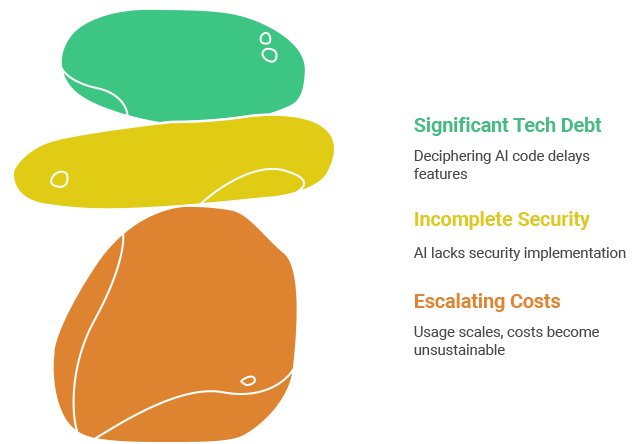For startup investors, demos have never looked better. Founders can now build polished, functional apps in weeks instead of months thanks to AI-powered coding tools like Cursor and Replit. The prototypes work smoothly, the user interfaces are clean, and the value proposition is clear. It’s easier than ever to see their potential and write the check.
But behind those impressive demos lies a latent risk: apps built on shaky technical foundations that won’t withstand the pressure of real-world growth. While AI can generate functional code quickly, it rarely considers security vulnerabilities, scalability bottlenecks, or long-term maintainability. These apps might work beautifully for 100 beta users, but crash at 10,000 users – or worse, suffer data breaches that destroy your investment overnight.
Traditional due diligence wasn’t designed for this new reality. You might analyze burn rates and customer acquisition costs, but do you know if the app can actually handle the growth you’re projecting? Vertical Motion’s Application Health Assessments fill this gap with the technical equivalent of financial due diligence – giving investors concrete data about the technology’s condition, risks, and long-term viability.
The pitfalls of scaling vibe-coded apps
Vibe coding is everywhere: TechCrunch reports that 25% of YC Combinator startups have codebases that are 95% AI-generated, and founders who want to stay competitive face pressure to use AI as much as possible.
But too much reliance on AI-generated code creates a perfect storm of technical risks:

Escalating operational costs
Vibe-coded applications rely heavily on expensive APIs and auto-scaling cloud services. As usage scales into new service tiers, costs can quickly become unsustainable, racking up thousands before generating a single dollar of revenue.
Incomplete security implementation
Jeremy Kantz, managing partner at Sentinel Global, estimates that vibe coders spend less than 10% of go-to-market budgets on security. AI tools don’t implement security or compliance frameworks, so a lack of oversight can be a huge risk.
Significant tech debt
AI code often contains structural problems that create significant tech debt. When it’s time to scale, new developers will need to decipher AI-generated code – delaying features and creating extra costs just when startups need maximum agility.
How an Application Health Assessment can help you assess risk
Just like you wouldn’t buy a house without a thorough inspection, it’s not ideal to fund an app without understanding its technical foundation. Our Application Health Assessment gives you a comprehensive analysis of the app’s code quality, scalability potential, security posture, and performance benchmarks so you know exactly what’s behind the next flashy demo.

Code quality
Poor code quality is like a house built on sand: it looks fine until pressure is applied. For example, a vibe-coded ecommerce app might work perfectly for simple purchases but crash when users try to apply discount codes. Without proper error handling, these failures can create costly downtime just as the business is trying to scale.
Watch for
Frequent bugs, delayed feature requests, or founders who can’t explain their code architecture in simple terms.
What the AHA tells you
You’ll get a third-party unbiased perspective on code quality, clarity on any critical software issues, and an overview of future maintenance costs.
Scalability potential
Developers under pressure to build quickly with AI often add workarounds with redundant code rather than refactoring it. GitClear found that 46% of code changes were new lines in 2024, which can lead to bloated codebases that are expensive to run and slow to execute. Copy-paste techniques also create multiple versions of the same code that all need to be maintained independently, increasing development costs later.
Watch for
Slow loading times, a lack of monitoring or performance analytics, or vague answers about infrastructure costs.
What the AHA tells you
You’ll get a third-party unbiased perspective on code quality, clarity on any critical software issues, and an overview of future maintenance costs.
Security posture
Security frameworks are crucial for highly regulated industries, and apps that lack appropriate data and privacy controls can risk hefty fines. A healthcare app might successfully store patient data and display it beautifully – but without proper encryption, audit trails, and access controls, it’s a potential compliance disaster that could result in penalties of up to $1.5 million.
Watch for
No data classification or handling procedures, missing audit trails for sensitive data access, or a lack of clear policies for data retention and deletion.
What the AHA tells you
You’ll understand exactly which regulations apply to your investment and whether the technical implementation actually meets legal requirements.
Dependency management
Vibe-coded apps often use whatever dependencies AI tools suggest without considering their age, security status, or long-term viability. For example, the Log4j vulnerability discovered in 2021 still poses risks today because many applications still use vulnerable versions buried deep in their dependency chains. When developers ask AI tools to “add logging functionality,” they might unknowingly incorporate affected libraries.
Watch for
Founders who can’t list their major dependencies, no update schedule for third-party libraries, using unfamiliar or obscure packages,
What the AHA tells you
You’ll get a complete inventory of all dependencies with version information, along with exactly what components need updating.
Questions every investor should ask before funding an app
What's your monthly burn rate on development tools, AI credits, and cloud services?
Vibe-coded apps built on expensive, auto-scaling cloud services can rack up thousands in AI API costs before generating revenue. Founders should be able to answer with specific monthly figures, and be able to answer hypothetical questions about how costs would scale with usage.
How long did it take to build your MVP, and what percentage of it was AI-generated?
Suspiciously fast development timelines (weeks instead of months) often mean corners were cut on security, testing, and architecture planning. Listen for realistic timelines that include planning, testing, and refinement phases – not “We built it in two weeks.” If a significant portion of the app was built with AI, founders should be able to describe their code review process.
How do you handle user data, and are you compliant with GDPR/PIPEDA/other regulations?
Compliance is complex, and often AI-generated code won’t build compliant apps. Legal liability can be enormous if data protection isn’t properly implemented. Founders should have clear data handling procedures, and know how data is protected across their entire ecosystem.
What’s your incident response plan if there’s a security breach or major outage?
Teams need to prepare for the worst and think beyond the happy path. This requires technical expertise that goes beyond coding. Look for written incident response procedures, regular backups, and alert systems. They should have designated team members for different types of emergencies, and practice their response plans.
Who on your team can explain and modify the codebase besides your original developer?
It’s a major risk if only one person understands the codebase, especially since AI-generated code is often poorly documented and difficult to maintain. Founders should have multiple team members familiar with different parts of the system, comprehensive documentation, or clear strategies for onboarding new developers.
What metrics do you track for application performance, and how do you know when something is wrong?
Founders shouldn’t be waiting for users to tell them if something is wrong. Instead, they should be able to point to specific performance metrics, have monitoring tools in place, and specify clear thresholds for when they investigate issues.
Protect your portfolio with digital due diligence
The difference between a good investment and an expensive lesson often lies in what you can’t see during the pitch meeting. Our Application Health Assessments help you understand exactly what you’re investing in, and decide whether any issues are something you can work through or something you should walk away from.
Ready to add technical due diligence to your investment strategy? Start by incorporating technical screening questions into your initial conversations. For startups that show promise, schedule an Application Health Assessment before you commit significant capital. Think of it as standard practice, just like financial audits, market validation, and reference checks.
When vibe coding can make any app look ready to scale, the investors who pick more winners will be ones who look under the hood. Your portfolio – and your partners – will thank you for it.
Vertical Motion is a trusted Canadian software development and entrepreneur assistance company that has supported the global efforts of startups, non-profits, B2B, and B2C businesses since 2006. With headquarters in Calgary and Kelowna, and team members coast to coast, Vertical Motion is recognized as an award-winning leader in the technology industry. Our team of executive advisors, project managers, software developers, business analysts, marketing specialists, and graphic designers have extensive experience in several industries including — Energy, Finance, Blockchain, Real Estate, Health Care, Clean Technology, Clothing & Apparel, Sports & Recreation, Software as a Service (SaaS), and Augmented & Virtual Reality (AR/VR).
Come chat with us and let us take you “From Idea to Execution and Beyond!” 🚀
